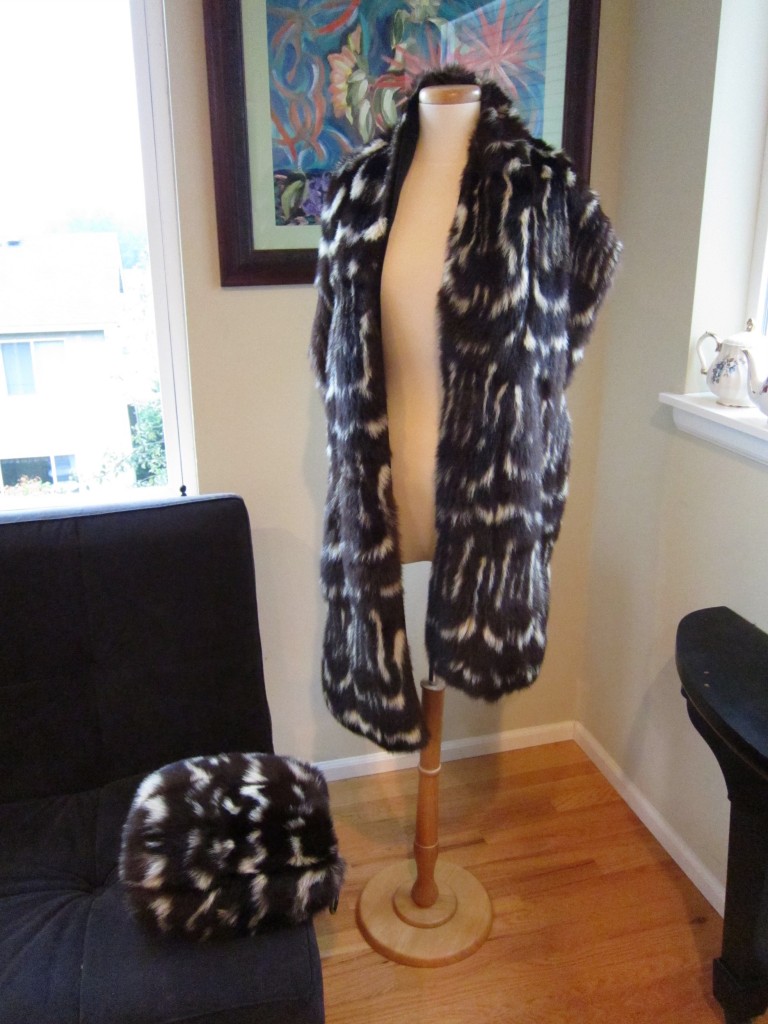
Natural Skunk Fur Stole and Matching Muff ~ C 1940s ~ From the Lady Violette Vintage Fur Collection
I have an extensive collection of vintage furs and people always wonder what kinds of furs they are. Some are quite unusual and seldom seen these days. I have decided to research all of them thoroughly and have consulted a professional furrier Rene Vogel for authentification. Mr. Vogel is a second generation Swiss custom furrier who was the house furrier for Nordstroms when they were still selling furs and I. Magnin when they were still in business and selling furs. He has decades of experience having been in the business himself since 1969, as well as growing up around it because his father was also a furrier. He is very familiar with the styles and types of furs worn over the past decades in both Europe and America. Rene Vogel now works independently by appointment and his business is Furs by Rene. He is located in the Seattle area. He can be reached at 425- 322-9638. He does custom designs, restyles, alterations, repairs, storage and cleaning. His email is rdcvogel@msn.com
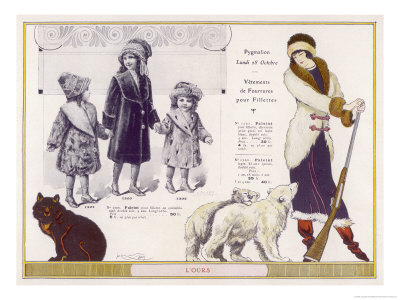
Jacques Nam ~ Polar Bear Fur Coat & Coats of Fur for Children ~ 1912
I plan to work my way through my own collection of furs and post each fur with extensive photos and a description in the hope of helping people to make correct identification of furs they have or would perhaps eventually like to acquire! And for the purpose of correct historical identification of the furs used in creating these spectacular vintage fashions. I think the use of furs is a fascinating part of our social history. At this point I will explain that I do not buy or wear new leather or fur clothing, I only recycle vintage. Many of the furs I have now I inherited from family members and elderly friends who know I have an interest in them. My interest is in identifying the furs accurately, preserving and repairing them if necessary, wearing them when it is appropriate, and education about furs and their place in history and society ~ in other words, social studies. I do advocate wearing a recycled fur if you wish to wear one and I feel we show our respect for the animals used in the making of these old furs by learning about them and caring for them properly. I personally feel it shows more respect to an animal who was made into a fur coat years ago to wear it respectfully than to bury it in a landfill before its beauty and useful life have naturally expired. Wearing an antique of vintage fur out in public gives you an opportunity to educate people on the topic of furs and the preservation of endangered species. I see this as an animal rights and environmental education opportunity.

Skunk Stole Made of 24 Skunk Pelts & Matching Muff Made of 6 Skunk Pelts
This fabulous vintage 1940s fur ensemble is a very dramatic black/ brown and white skunk stole and muff. The stole is comprised of 24 skunk pelts arranged with 3 pelts sewn together side by side width wise by eight pelts lengthwise creating a rectangular stole that is 13 ” wide by 86 ” long. The matching muff is comprised of 6 skunk pelts joined side by side and formed into cylinder which is lined in heavy black satin and stuffed with down feathers. The natural pattern of white against black/ brown fur in the skunks coats creates an interesting zigzag effect when the pelts are joined together side by side. The coloration in this ensemble is natural, not dyed. It is black with very dark brown undertones and cream patterning when you hold it in bright natural light. In the photo below the skunk fur muff is placed on a black ultra suede upholstered sofa and is in bright natural light which allows you to see that it has brown tones within the black ones.
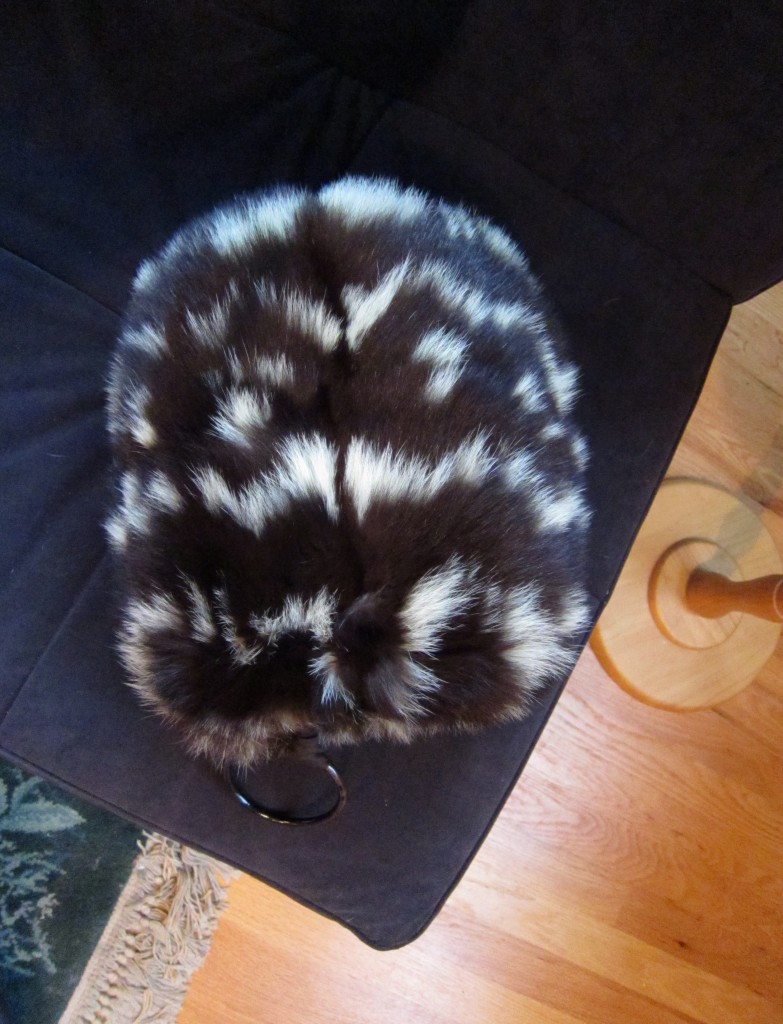
Cozy Muff is a Cylinder of 6 Skunk Pelts Joined Side by Side, Lined in Black Satin and Stuffed with Down Feathers to Keep Your Hands Warm! There is a Black Bakelite Bangle Attached so You Can Secure The Muff By Wearing it on Your Wrist Like a Bracelet. It is Beautifully Warm!
Skunk was often dyed solid blue black in order to disguise its identity and called ” American Sable” because some people did not like the identity of a skunk associated with their elegant fur garment. Personally I really like the natural coloring and the pattern produced by joining the skins side by side and end to end. I also like the softness of the natural coloring versus dark blue/ black because it is more flattering to my skin tone and easier to wear than stark blue/ black.
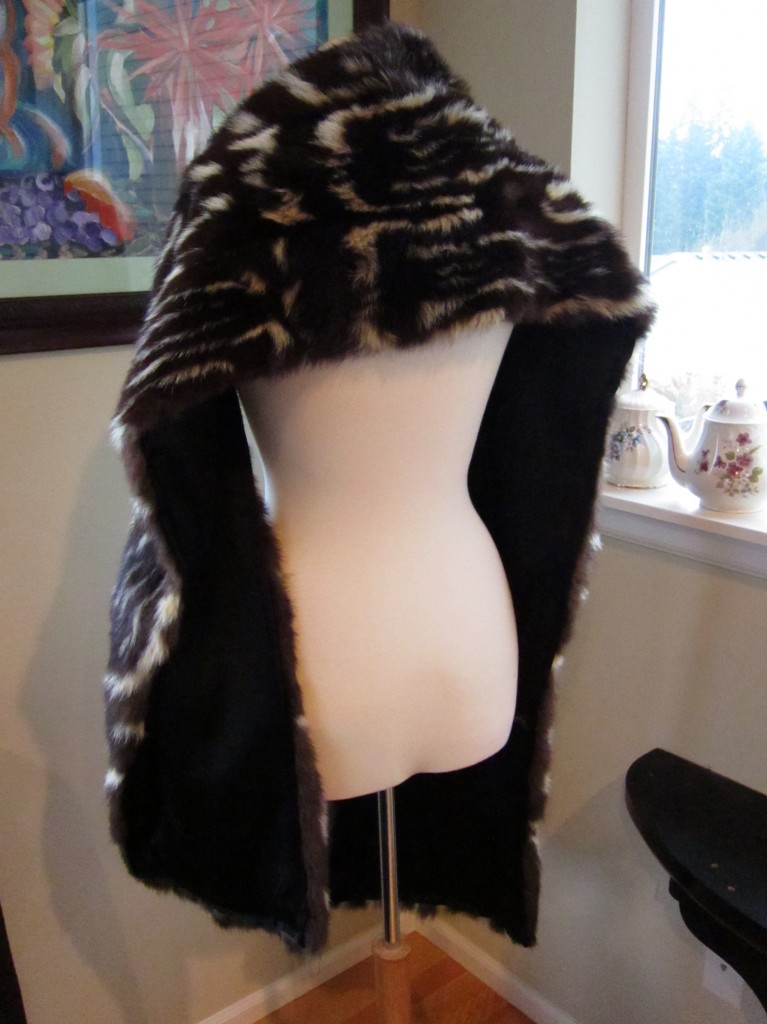
Back View of Vintage Natural Skunk Stole Circa 1940s
Here is a back view of this stole on a mannequin showing the length and proportion it had when worn. It is 86 ” long by 13″ wide ~ a glamorous and generous size for wrapping around the shoulders or draping for a highly dramatic entrance to an event over a bias cut 1940s evening gown. In writing this piece I choose to call this a stole but it can also be considered a scarf and a shawl when you are deciding how to style and wear it. You could even use it as a gigantic muffler or as a throw over a piece of furniture in your interior decor. There is an art to using furs and if you get creative you can figure out many ways to wear them and other interesting ways to use them. It is important to recognize the furriers skill as an art form and experiment with ways to wear his creations.
In former more elegant time periods it seems that women dressed with a great deal more attention to the beautiful effects they were creating and the lasting impressions they made. The ability to do this was considered a valuable talent and a respected female accomplishment. It was viewed positively as one of the feminine arts. Of course many men did this too. In my opinion many more men used to give attention to the way they dressed than they do so today.
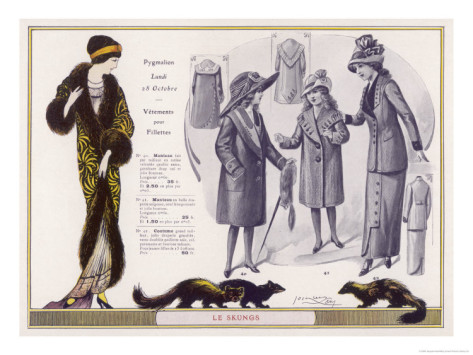
Jacques Nam ~ Evening Coat Trimmed in Skunk Fur and Tailor Made Children's Clothes
Many men and women were employed in the professions that helped these fashionable women to achieve their great degree of elegance. Consider the couture designers of clothing and furs, the jewelers, the textile manufacturers, the perfumers, the shoe designers, the milliners or hat makers, in fact the designers of every item these refined and beautiful people consumed and needed! Consider the craftsmen and trades people who supported the fur industry ~ the trappers, the tanners, the taxidermists, the fur dealers, the trade companies, the exporters and importers, the furriers, the seamstresses, the stores and shops and sales staff and models and photographers and illustrators and fashion editors! And so on, as there are undoubtedly many more categories of middle men and support people than I have quickly thought of here. The amount of work involved in the fur industry in the past and and the numbers of people employed by it and involved in executing it is amazing to contemplate in retrospect. The fur part of the fashion industry has been as large and complex as any other part of the fashion industry in past eras. Now it is barely hanging on.
It is a now dying art form and profession and most of the furriers have closed shop in American cities. It is difficult to find a professional furrier to work with you anymore. I learned today that the only one left working in Portland, OR is Nicholas Ungar and the only one I know of in Seattle is Rene Vogel. The others have had to close down due to lack of demand for real furs. You may read in the press that fur is suddenly in demand again, but there is not enough demand to keep a small professional craftsman in a relatively large city in the United States in business. What is shown in a European fashion magazine’s artistic photo layout is no real indication of what is happening on a business level for these artisans and small business people. Antique dealers who sold vintage furs in Seattle four years ago have completely stopped and the last exclusive Fur shop in Bellevue, WA closed 2 years ago due to lack of adequate sales to stay in business. The department stores no longer have fur salons. All of them used to.
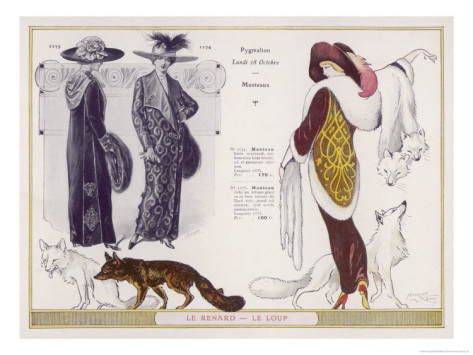
Jacques Nam ~ Fox Fur Stole ~ 1912
This is why I consider my beautiful vintage furs to be real treasures. They are rare and lovely and, in my opinion very worth the difficulty and expense of collecting, caring for, storing and maintaining. It is important to point out, here, that the furs need to be regularly cleaned to maintain the suppleness of the leather and keep the pelts from drying out and disintegrating. That means once every couple of years at least. During the summer they need to be put in cold storage for temperature and humidity control. It costs about $100 to clean a fur garment and about $60 a year to store it professionally during the summer season. You must also repair any little damages or stresses such as torn pocket edges or little splits that occur in the pelts as soon as you discover them. This must be done by a professional ~ the furrier ~ in order to be done properly. We need these guys! Furs are really quite delicate and need to be treated accordingly. They should be hung on wide padded hangers in a cool dark place with plenty of air circulation. They should not be exposed to light as they will oxidize and change color ~ very quickly. Like fine art which they are, too, they need to be stored in the dark.
There are a lot of details and lots to remember about caring for and wearing vintage furs but it is all interesting and ultimately well worth it! Like any area of special interest collecting vintage furs requires discipline and commitment. Like caring for a live pet requires love and attention, so does properly maintaining your fur and the way I see it doing so is also respecting the animals from which it came.
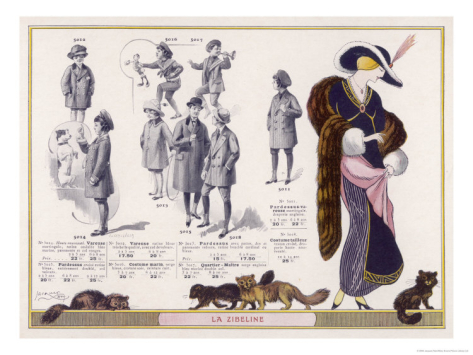
Jacques Nam ~ Sable Fur Scarf ~ Dress with White Fur Cuffs and a fur Trimmed Hat ~ 1912
I envision several ways of wearing my skunk fur stole and muff; first as an elegant evening wrap over a dark black/brown full length bias cut 1940s evening gown; second as a warm shawl and extravagant extra layer of warmth wrapped over my 1950s brown and black with cream tweed skirt suit along with the matching skunk fur muff to keep my elegantly vintage gloved hands even warmer; and third and finally, as a deco patterned black and white fur scarf over a slim calf length black wool coat with a high black fur collar and deep black fur cuffs as they did in Paris at the turn of the twentieth century. In those days they often mixed fur types and colors to achieve unusual color and textural combinations and proportions and it worked beautifully. They also combined furs with textiles in ways we would consider unusual today to great dramatic effect. Studying the way furs were worn in history gives you many new ideas on ways to use a vintage fur if you have one. Inspiration can be taken from any place and any time period. If you have any vintage piece I encourage you to experiment to find ways to wear it combined with contemporary items for a look all your own that is distinctively new and one of a kind to you today. The three outfits I create for myself with my skunk fur stole and muff and other clothing that I own each draw their inspiration from different past fashion eras. I do not copy those eras to the letter. I draw from them and apply them to myself to achieve a look that I feel is appropriate to my personal style and life today.
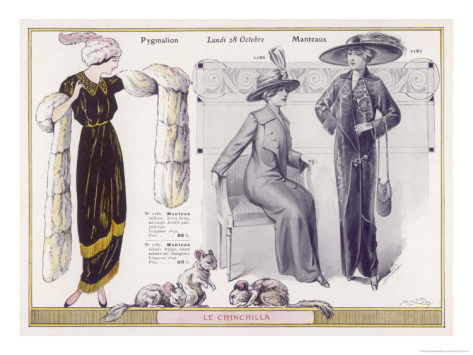
Jacques Nam ~ Chinchilla Toque and Scarf ~ 1912
After I finish photographing and documenting my furs and identifying what types of furs they all are. I intend to style them and photograph them on human models showing several different and relevant ways in which each one can be styled and worn today. I like to experiment with this ahead of having to be somewhere all dressed up on a schedule! I find preparing and planing in advance really saves me time and cuts down on stress when getting ready for an event. And I also enjoy the planning and experimentation part of dressing. I do not enjoy being pressured however so I try to prepare in advance! Remember, “Rushing is not glamorous!” is one of my favorite quotes.I think it is a great luxury to be able to get ready in a leisurely manner.
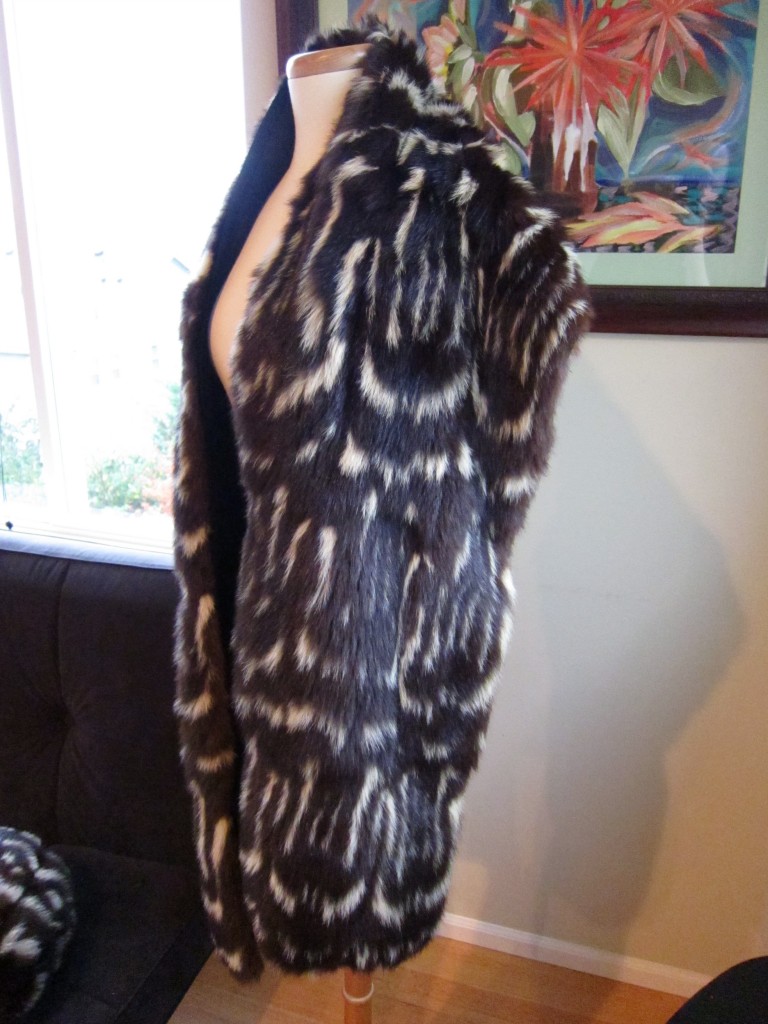
Side View Shows the Repetitive Art Deco Pattern Created When the Skunk Skins are Joined Together Side by Side and End to End.
A side ways view above shows the repetitive patterns of the skunk skins in the little V shapes that are created when the furrier joined them together. I think the designs of the joined furs look very Art Deco. I imagine descending a curving staircase in that long black/ brown satin bias cut 1940s evening gown wrapped in this beauty or making a red carpet entrance in it ~ Just imagine the photo opportunities! I think the press would go insane! Or at the very least mad! An actress would definitely catch their attention if she were wearing these unusual pieces on the red carpet today! They are so simple, yet so elegant and all because of the natural beauty of the humble little skunk!
Any actresses out there, or their stylists, please contact me and arrange to use my skunk fur ensemble for such an event rather than having a new one made. I in no way wish to advocate the creation of a new skunk fur ensemble by showing this vintage one on my blog. Alternatively it might be possible to make a similar one out of faux fur, but I have personally never seen faux fur of this type.
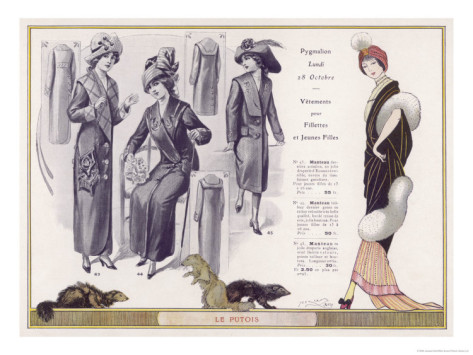
Jacques Nam ~ Evening Dress with Polecat Fur Mantle Trimmed in White Fur~ 1912
My authentic skunk stole and matching muff are lined in a black satin with an embossed leaf pattern. The stole bears a small label sewn in the side seam for the the Seattle store Jay Jacobs Seattle where it was originally sold. It has the original owners monogram initials HV appliqued on the lining. I find it interesting that they sewed in the owner’s initials as an applique that could be easily applied with a few well placed stitches or removed easily by picking out the threads that hold it in place and changed to another owners initials should this garment change hands! I’ll have to look into changing them to my own! Jay Jacobs Stores existed from 1941 to 1999. This ensemble was created and sold in the early 194os.
I acquired this skunk set about 20 years ago from an elderly friend of my mothers who was no longer able use it. She had worked at Jay Jacobs first store store in the early 1940s and bought it during that time. I have found elderly lady friends to be a great source of older fur styles. They are often happy that I show interest in the furs they treasured and the periods of time when they acquired and wore them. I have acquired several beautiful furs and other articles of vintage finery this way. I always promise to keep their fur, take good care of it and wear it out, to special events as they would have done back in the day. I promise, essentially, to treat it like a beloved pet. And I wear it when I go to visit them which they love!
In the olden days skunk would sometimes smell, well, a little bit skunky, if it got wet! However the furriers found a way to eliminate the natural odor of the skunk animal so an elegant wearer was only identifiable by her French couture perfume.
The interesting historical tidbit on skunk fur below is courtesy of the Vintage Fashion Guild’s Fur Resource on skunk where close up photos of several colors of skunk fur and several other vintage garments made of skunk pelts are also pictured. This section was written by Pauline Cameron and Katie Kelmsley.
“Skunk fur is rather long, with coarse, glossy guard hairs of about one to two inches, which have the qualities of strength and longevity. Normally the under-fur is grayish underneath the black guard hairs and white underneath the white guard hairs. If the more valuable all-black pelts were not used or available, the entire pelt was dyed a uniform, glossy black.
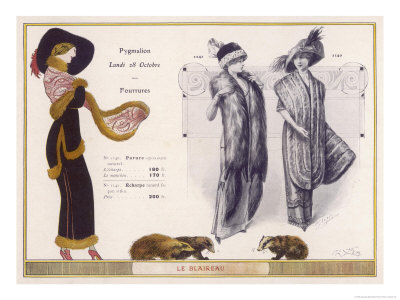
Jacques Nam ~ Badger Fur Trimmed Tunic, Skirt,and Printed Stole ~ 1912
Skunk fur has been used in the fur industry as early as the mid 1800’s, gradually increasing in popularity into the 1900’s when it exceeded production of the most traded fur – Muskrat. As the United States recovered from the Great Depression a strong market for fur trimmed cloth coats created a demand for skunk, with pelts doubling in price into the early 1940’s. Previous to the 1950’s it was sold under different names including Alaskan Sable, and American Sable.
After the identity of the fur was known, Skunk took a dive in popularity. This continued into the early 1970’s at which time the offbeat, unconventionality of it seemed to restore its appeal for a brief time after which it went out of use again. An upsurge in the popularity of Skunk fur has taken place with fashion houses such as Prada and Fendi using the black or brown-and-white varieties in items from handbags to throws and long, sweeping coats.
“The hop growers loved the skunk because they ate the hop grubs that damaged the hop vines. The hop growers of the state, centered in Madison County, petitioned the State Legislature to pass a law giving the skunk a closed season. Thus the skunk became the first New York State furbearer to have legal protection!” “Many times a farm boy could earn more in a season’s trapping than his father made in a year on the farm. Skunks saved some farms during the Depression by the income from their pelts.“ Norman Evans, Stories From Old Georgetown.”

Jacques Nam - Full length Coats Trimmed in Beaver, Otter, Opossum or Ermine and a Long Fur Boa or Scarf~ 1912
Scarves, Stoles and Muffs in Skunk were also popular in fashionable cities in Europe in the early 1900s. The French fur fashion illustrator Jacques Nam did charming drawings for fashion plates and magazines depicting elegant women wrapped in in furs surrounded by the animals from which they were made as if they were darling personal pets. The greatest value in these pictures is seeing how the fur garments were initially meant to be worn when the designs were conceived and the clothing was made and accurate pictures of the animals whose pelts were used. Jacques Nam’s animals are very accurately rendered even though it is his fantasy that a woman would be walking her pet skunks, muskrats or leopards along the boulevard like two pet dogs while wearing an ensemble of a skunk stole and muff! You can get a lot of charming ideas of ways to wear your vintage furs by looking at his work.
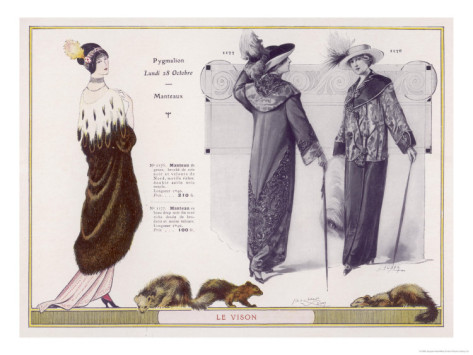
Jacques Nam ~ an Evening Mantle in Mink with an Ermine Cape Collar ~ 1912
Note the fur stoles and muffs on the center woman below. That one makes me want to wear my skunk set with a straight long black dress and an amazing large brimmed black vintage hat trimmed in a cream ribbons and a soft tuft of black and brown feathers chosen to compliment the natural colors in the skunk fur. And dainty little shoes in a combination of cream and black with brown feathered shoe clips… Pictures like this make my imagination run wild on ways to wear my vintage furs!
Google Images gallery of Jacques Nam’s work.
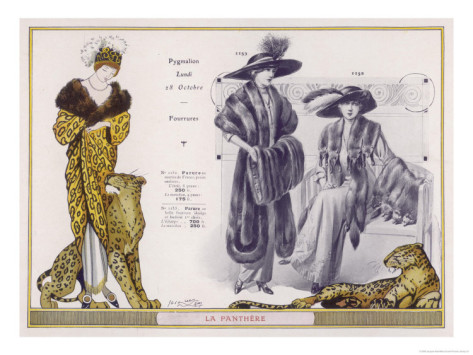
Jacques Nam's Illustration of Fur Stole and Muff ~ about 1912
Finally I want to point out that I have included the Artist Jacques Nam’s illustrations in order to introduce you to his work and trigger your imagination in how to wear vintage fur styles. Much of his work is sheer exotic fantasy and would be great fun to own and wear, but, if one decided to reproduce it today I feel it would be best to do so in faux furs. I think this is entirely possible to do using vintage patterns available on Etsy and eBay.
I saw a Polish Folk Festival fashion show of native Polish costumes a couple of weeks ago. One of the men’s full length wool capes was trimmed using a 1940s woman’s vintage squirrel evening stole to make a wide shawl collar at the top, almost like a second short cape, that just covered the man’s shoulders. Thus a vintage woman’s stole was used to make a contemporary man’s fur trimmed cape. And it was gorgeous! The costume designer had recycled the original stole, using every bit of a second hand fur to create an elegant wide fur collar on a new garment. It was absolutely stunning! This is a perfect example of using an old fur garment to inspire you to create a successful new one! I spoke to her after the event and she told me she had bought the shawl at the Goodwill for $37! I am just waiting until I have two similar pieces to put together to create a sweeping floor length wool cape with a vintage fur collar!
 Here is the amazing full length sable again ~ photographed in New York City with throngs of adoring fans looking on! Grace, as usual looking really warm and happy.
Here is the amazing full length sable again ~ photographed in New York City with throngs of adoring fans looking on! Grace, as usual looking really warm and happy.
































